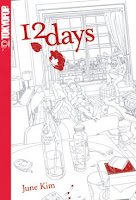 Creator: June Kim
Creator: June Kim
Publisher: Tokyopop
ISBN: 9781598166910
Released: November 2006
June Kim is a Korean-born comics artist and illustrator who currently lives and works in the United States. Although some of her short comics had previously been collected in various anthologies, 12 Days was her first and, as far as I know, only graphic novel to have been published. What I can say for certain is that 12 Days was my introduction to Kim and her work. 12 Days was released by Tokyopop in 2006. The book’s cover design is really quite lovely with silver foil line work and striking red accents. Tokyopop didn’t always take such care with the presentation of its releases, so this was nice to see. 12 Days is at least partially based on a true story—a sad tale that a stranger told to Kim about her ex-girlfriend. Kim herself originally developed the story of 12 Days while getting over a breakup in her sophomore year of college. However, it wasn’t until 12 Days was picked up by Tokyopop that she completed the graphic novel.
On the way back from her honeymoon, Noah was in a lethal car accident. That was a month ago. Noah’s death hits her ex-girlfriend Jackie hard. Already a wreck from their breakup, Jackie is faced with the reality that she has now completely lost the love of her life. And so she devises a way to forget and finally let go. Over the course of twelve days she will drink Noah’s ashes as part of a personal ritual. Somehow Jackie convinces Nick, Noah’s half-brother, to steal some of his sister’s ashes for her from the urn on his parents’ mantle. It’s under these strange circumstances that the two most important people in Noah’s life meet. Nick and Jackie are each struggling to accept and cope with Noah’s death in their own ways. Their shared experience becomes a source of comfort as much as it is a source of pain. They both loved Noah dearly and it will take far more than twelve days to ever change that.
Kim’s style in 12 Days is influenced by both manga and manhwa as well as by independent comics. A prominent theme in both the artwork and narrative of 12 Days is reflection. This can be seen in Kim’s use of mirrors in the graphic novel, but also in the page layouts and panel composition. Jackie and Nick’s actions and how they are captured in the artwork often parallel or echo each other, providing yet another tenuous connection between the two of them. The narrative itself isn’t linear. Much of the story is told through the flashbacks, dreams, and memories that intrude upon Nick and Jackie’s lives. It’s as if a mirror containing all of their thoughts of Noah has been shattered and they are left picking up the pieces—a fitting metaphor for the grieving process. Some of the transitions can be a little difficult to follow at first, but overall it as a remarkably effective approach.
As a whole 12 Days is a very reflective and introspective work. There is intensity and drama but it’s not overblown; the graphic novel tends to be rather intimate and quiet. Despite the realistic portrayal of the complexities of grief, family, love, and loss, 12 Days is not overwhelmingly bleak or depressing. The graphic novel can certainly be heartbreaking considering Noah’s death, the circumstances surrounding her and Jackie’s breakups, and some of society’s prevailing attitudes towards same-sex love, but there is also a fair amount of humor in 12 Days that keeps things from getting too heavy or dark. Even while dealing with the tragedies in their lives, Jackie and Nick, who are both endearingly eccentric, are still able to joke around and tease each other. Sometimes that humor can be a bittersweet reminder of what they have lost, though. 12 Days is a work that holds extraordinarily up well to multiple readings. In fact, I think I enjoyed and appreciated its subtleties even more after reading it several times.





